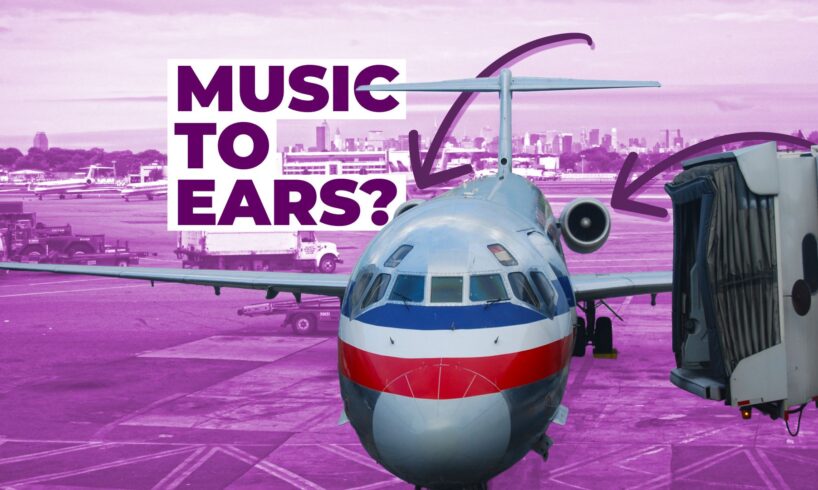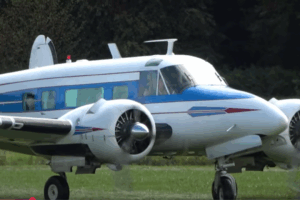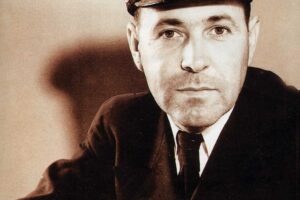
Aircraft and engine manufacturers today put a lot of effort into designing jets that balance efficiency, comfort, and performance. From advanced aerodynamics to refined interiors, every detail is intended to make the experience better for passengers and to meet the expectations of airlines operating them.
Propulsion technology has been key to that progress, be it in terms of driving improvements in fuel burn, creating a quieter atmosphere for passengers inside the cabin, or reducing the overall noise footprint around airports. One of the biggest changes over the decades has been how seriously noise is treated.
While every engine inevitably makes noise, modern turbofans are far quieter than their predecessors, and passengers no longer expect to spend hours listening to a deafening roar. But that was not always the case: in earlier decades, noise reduction was not a priority, and many jets of that era became known for how loud they were, both on the ground and in the air.
Low-Bypass Turbofans Made The MD-80 One Of The Loudest Jets
The McDonnell Douglas MD-80 was one of those aircraft that quickly earned a reputation for being too loud. A mid-size, medium-range airliner was introduced in the late 1970s and became a major player in the narrowbody market. At one point, it was considered the loudest commercial jet operating in the United States. The aircraft was developed as an extended and modernized version of the DC-9, aimed at the 140–170 seat market.
The series first flew in 1979 and entered service two years later, and became the most successful of the DC-9 family, with nearly half of all deliveries falling under the MD-80 variants. Airlines valued its reliability, its capacity, and its operating economics compared to the older trijets it often replaced. Yet, despite these advantages, its engine technology tied it to an era when noise levels were significantly higher than what would soon be expected.
The aircraft was powered by Pratt & Whitney’sJT8D engines, a low-bypass turbofan that had powered earlier aircraft like the Boeing 727 and the original DC-9. On the MD-80, the -200 series of the JT8D provided more thrust and efficiency than the earlier models, but it still had a bypass ratio of only around 1.74:1. This meant that a much larger portion of the air was passing through the hot engine core rather than bypassing it around the fan, creating an exhaust jet that was hotter, faster, and considerably louder.
The MD-80 Divided Opinion Among Passengers
Pratt & Whitney introduced the JT8D-200 in 1980 as the exclusive powerplant for the MD-80. The engines deliver between 18,500 and 21,000 pounds of thrust; more than 2,900 of the engines were built. According to the manufacturer, they complied with Stage 3 noise limits, which were the FAA and ICAO benchmarks of the time. Stage 3 replaced the earlier Stage 2 rules in the late 1970s and set maximum noise levels that jets could emit on takeoff, approach, and at the runway sideline.
For jets of the MD-80’s size, that meant staying below roughly 95 to 105 effective perceived noise in decibels (EPNdB), depending on weight and phase of flight. These limits indeed marked a step forward from the noisier early jets, but standards have continued to tighten since then. Today, according to the FAA, all new jets and large turboprops are required to meet Stage 5. At that time, for the MD-80, meeting Stage 3 was enough for certification, but that did not make it a quiet aircraft in practice.
Engine Characteristics
Specification
JT8D/-200
Fan Tip Diameter 54 inches
Length, Flange To Flangem168.6 inches
Takeoff Thrust Up to 21,000 of thrust
Flat Rated Temperature 84 Degrees F
Bypass Ratio1:74 to 1
Overall Pressure Ratio 18.2 to 19.4
Fan Pressure Ratio 1.91
In addition, engine placement meant that noise was distributed unevenly through the cabin. Passengers seated at the front often described the cabin as quiet because the engines were almost 80 feet behind them. In the rear, the noise was far more intense, and travelers often recalled that announcements could barely be heard over the roar. Ultimately, the MD-80 became one of those aircraft people either loved or disliked intensely.
The same layout also shaped how it was perceived on the ground, as the rear-mounted engines projected much of their exhaust downward and intensified the impact of takeoff and landing noise on surrounding neighborhoods. For those reasons, it picked up the nickname ‘Mad Dog,’ a simple play on its MD initials.
Today’s Jets Are So Much Quieter
Photo: Michael Derrer Fuchs | Shutterstock
As previously mentioned, the JT8D-200 that powered the MD-80 had a bypass ratio of just 1.74:1. That was higher than the original JT8D, which operated below 1:1, but still far below what later turbofans would achieve. In simple terms, it meant a large share of the air was forced through the engine core for combustion instead of bypassing around it. The exhaust that came out the back was faster and hotter, which made the aircraft louder than anything built to modern standards.
Modern engines are built around a very different philosophy. Today’s turbofans typically operate with bypass ratios between 9:1 and 15:1, which direct far more airflow around the core instead of through it. This lowers exhaust velocity and cuts noise significantly. For instance, the Rolls-Royce Trent XWB, which powers the Airbus A350, has a bypass ratio of about 9.6:1, one of the highest in the industry.
So, if you have ever flown on an A350, you would have noticed how quiet the cabin feels compared to older jets. The same is true for the Boeing 787 Dreamliner, which is powered by the General Electric GEnx and Rolls-Royce Trent 1000, both with bypass ratios in the 9:1 to 10:1 range. On the narrowbody front, Pratt & Whitney’s geared turbofan for the Airbus A320neo reaches 12.5:1, which is the highest currently in service, and has helped make the type one of the quietest single-aisle aircraft flying today.
Apart from this, modern jet engines also incorporate advanced materials and design improvements that make them quieter in day-to-day operation. One of the most visible examples is the use of chevrons, the serrated edges on engine nacelles seen on aircraft like the Boeing 787 and 737 MAX. These help mix the exhaust with the surrounding air more smoothly, which reduces the sharp shear noise that earlier engines produced.
Fan blade designs have also evolved, and now blades are more aerodynamically efficient and made from advanced composite materials that generate less turbulence and quieter airflow. In addition, airframe design plays a major role. Older aircraft had less efficient aerodynamics, which created more drag and forced engines to work harder and louder. Today’s jets feature smoother fuselages, raked wingtips, and redesigned flaps and slats, all of which help reduce noise during takeoff and landing.
The MD-80’s Commercial Success Despite Its Noise
Modern aircraft have largely solved the problem of noise, but that does not erase the fact that some of the older, louder jets were still hugely successful in their time. The MD-80 is a prime example. It was conceived as a stretched and updated version of the DC-9, offering airlines more seats, improved avionics, and updated engines. The aircraft first flew in October 1979 and entered service the following year with Swissair, an old national airline of Switzerland that filed for bankruptcy in 2002.
From there, it became a workhorse for carriers across the globe and remained in production until 1999, with nearly 1,200 delivered. American Airlines was the largest operator by far and flew over 300 aircraft, according to ch-aviation. The jet was the backbone of its domestic network for decades. Delta Air Lines also relied heavily on the MD-80 and was the last US operator to retire the aircraft. The airline phased it out in June 2020.
Across its production run, McDonnell Douglas built several variants of the type, including the MD-81, -82, -83, -87, and -88. The MD-81 was the standard model, the MD-82 offered more powerful engines for challenging conditions, the MD-83 added fuel capacity for longer missions, the shorter MD-87 reduced seating but improved field performance, and the MD-88 modernized the cockpit with electronic instruments.
Over 4,500 Flights Are Planned For The MD-80 In September
Photo: EvrenKalinbacak | Shutterstock
More than four decades after its introduction, the MD-80 has not completely disappeared from the skies. According to ch-aviation data, around 78 aircraft remain active today, including both passenger and freighter versions. This includes one MD-81, 18 MD-82s, 25 MD-83s, 15 MD-87s, and four MD-88s. Converted freighters also contribute to the total, with three MD-82SFs, 12 MD-83SFs, and five MD-88SFs still in service.
The operators that continue to rely on the type are spread across several regions, including Iran, Latin America, and parts of Africa. Airlines still flying MD-80s include ATA Airlines (Iran), World Atlantic Airlines in the United States, Caspian Airlines, Zagros Airlines, African Express Airways, Iran Airtour, Kish Air, LASER Airlines, Tez Jet Airlines in Kyrgyzstan, Venezolana, Red Air, and Mexico-based Aeronaves TSM.
Data from an aviation analytics firm, Cirium, shows that more than 4,500 flights are planned for the MD-80 family next month. Iran’s ATA Airlines is scheduled to operate the highest number of flights, around 1,158. These flights will be operated by its fleet of seven MD-83s. Iran Airtour, a private carrier, is also scheduled for 848 flights, while Kyrgyz carrier Tez Jet has nearly 500 scheduled services. Venezuela is another hotspot, where Caracas-based LASER Airlines is set to operate 230 flights with the type.
Loud, Reliable, And Unforgettable
The MD-80 may still be flying in small numbers today, but it will always be remembered for the sound of its engines. The JT8D-200 was considered a capable design in its day, yet it had a noise profile that was hard to miss both inside the cabin and on the ground. For many travelers and communities near airports, that roar became the aircraft’s defining trait.
Modern jets have taken a very different path. High-bypass turbofans, acoustic liners, and aerodynamic improvements have made aircraft like the Airbus A350, Boeing 787, and A320neo some of the quietest ever built. The contrast with the MD-80 shows just how far propulsion technology has come in the decades since.
Even so, the MD-80 left a strong mark on aviation. It was reliable, economical for its time, and central to the fleets of some of the world’s largest airlines. More than 40 years after its first flight, a handful of examples are still in service that are carrying forward the legacy of a jet that was as successful as it was loud.



